Photo Journey: Alaska Wildlife
Alaska is one of the most diverse ecosystems on Earth. From glaciers to coastlines, wetlands to plains, the beauty of Alaska is only surpassed by the wildlife that make it their home. Animals that we commonly see in the lower 48 like bald eagles and squirrels are much larger in Alaska, and other animals like moose and seals are almost an everyday occurrence.
From the bus trip through Denali National Park to wildlife cruises along the coast, Alaska is one of top wildlife destinations in the world. I might not have seen every type of animal during my summer in Alaska, but my encounters were such a thrill that I still get that rush of adrenaline when I look back through my photos today.
Disclosure: Some links may be affiliate links where we receive a small commission at no additional cost to you.
Best Way to View Wildlife
The best way to view wildlife is through a good telephoto lens. Alaska is a photographers’ dream with mountain landscapes, reflective water and fantastic wildlife. Invest in a good DSLR camera with a telephoto lens of at least 300mm. If you can go bigger, do it. All the pictures in this post were taken with a Canon DSLR camera.
A Few Words of Caution on Viewing Wildlife
You should never approach wildlife. Alaska is a wild country and these animals are wild. Some may be used to weird humans gawking at them from afar, but they will not be receptive to a selfie with you. Bears, foxes and coyotes may approach human occupied areas searching for easy food. They may see you as competition and become aggressive. Keep your distance at all times. If you are outside your car or cabin and spot a wild animal, never turn your back to them. Walk backwards or sideways towards the safety of your vehicle or structure.
The animals below and the places to observe them are within easy access of Anchorage airport and cruise port destinations.
Salmon
Salmon may be be hard to spot in the open ocean, but can easily be seen as they make their journey back up the rivers to their spawning areas. Five species of salmon live, breed and die in Alaska waters. Chinook is the largest of the salmon species and pink salmon is the smallest. The other salmon species are Coho, Chum and Sockeye.
All salmon are born in freshwater and make their way to the ocean to grow to maturity, then return to freshwater to spawn and die. In the ocean, their colorations can vary from silver to bluish-green. The sockeye salmon is probably the most brilliant as it returns to spawn. Its body will turn bright red and its head will turn green.
The different species of salmon journey up river at different times of the season between May and September with August being the most active month. Cooper Landing on the Kenai River is a fantastic place for fishing and spotting salmon.
Moose
Moose are easy to distinguish from the other members of the deer family because of their bulbous noses, curved hump across the shoulders, and their flat antlers that resembles open hands. Did you know that moose can close their nostrils when foraging underwater? You’ll find moose near ponds and lakes during the summer eating aquatic plants. In winter, they dig in the snow for underlying dry grass and twigs.
On my drives to and from Anchorage, I spotted moose along the highway many times, but never had a chance to stop. Out near Bear Lake where I rowed with the Kenai Crewsers Rowing Club, residents would see moose lumbering through their neighborhood all the time. Your best chance to see a moose up close safely is at the Alaska Wildlife Conservation Center.


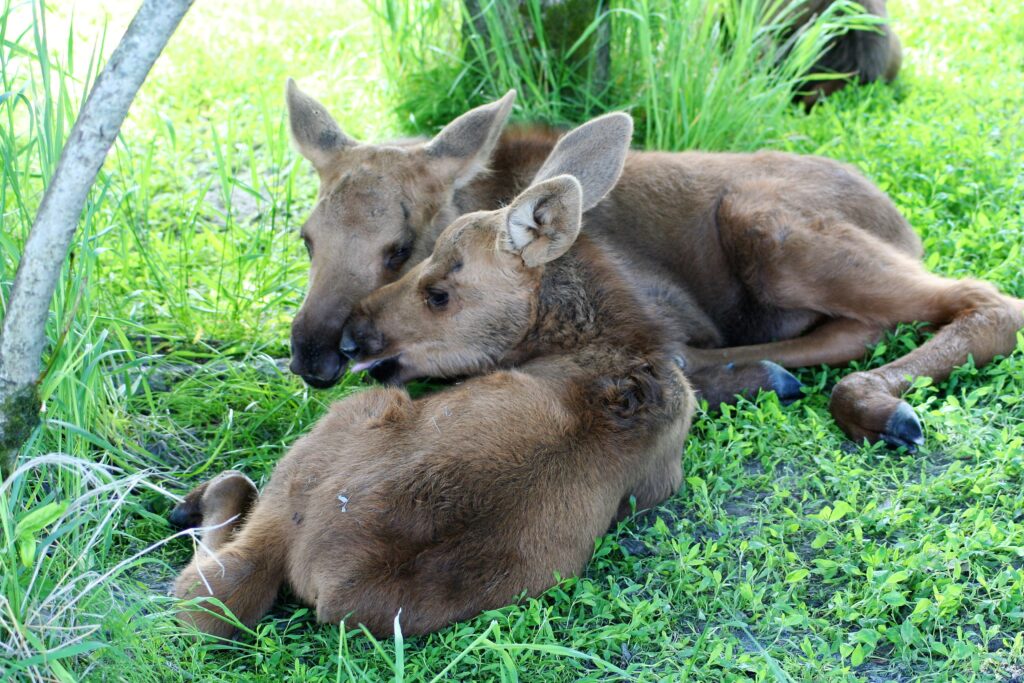
How Can You Tell the Difference Between Elk and Caribou?
Caribou can be seen crossing dry riverbeds in Denali during the summer. Both male and female caribou grow antlers with a distinguished C-shape, though females have a smaller rack.
Elk used to roam throughout the interior of Alaska, but today the only elk you will find have been transplanted from Washington to the islands of Afognak Island, Raspberry Island and Etolin Island and Zarembo Island in the southeast. If you are near Anchorage, visit the Alaska Wildlife Conservation Center to see elk and caribou in close proximity to see the differences between the two.
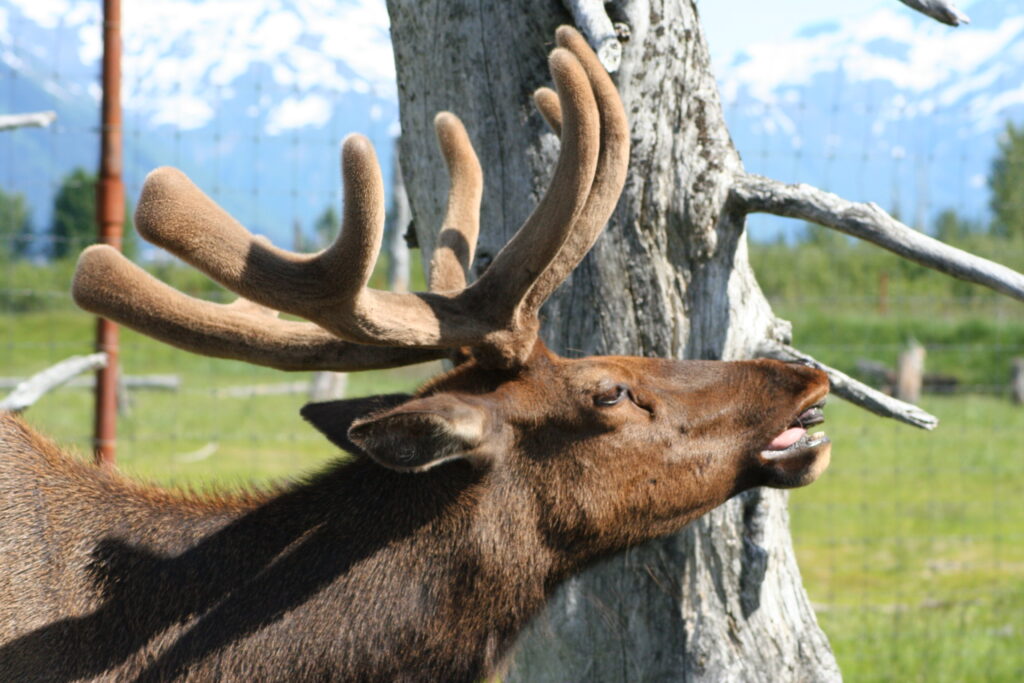
Sea Otters
My favorite animal on Earth is the sea otter. I could go on and on about them, but I’ll save that for another post. Sea otters swim and float on their backs and live their entire lives in the ocean along the coast. You will hardly ever see a sea otter on land unless its injured or there was a storm.
The Northern sea otter population extends from Washington state to Alaska and across the Bering Strait to Japan. The southern sea otter species occupies pockets of coastal areas around Central California. Sea urchins, clams, mussels and shrimp are their favorite foods. Sea otters can be solitary or live in groups called rafts. Males can weigh between 80-100 pounds. Females are smaller and weigh less. They are the only marine mammal that does not have blubber. Instead they have a thick fur coat with over 2 million hairs per inch. Sea otters constantly groom their fur and blow air between the hair and skin to keep themselves waterproof.
Sea otters prefer to keep their distance when boats are in the area. This is where a really good telephoto lens with a stabilizer will come in handy. I saw sea otters on all my wildlife cruises in Seward and Whittier. On a few occasions, I would see a lone male serpentine through the Seward marina looking for fish scraps from the daily fish cleaning stations.



River Otters
River otters in contrast are much smaller and live on land. They weigh around 20 pounds and can be found playing near lakes, rivers and the coast. They live in family groups with or without a male, or bachelor groups and sleep in dens. River otters have a varied diet of fish, shrimp, frogs, and water crustaceans. I was out kayaking one day and saw a family of river otters playing on the beach. By the time I arrived, they were long gone, but I couldn’t resist taking a picture of their cute little pawprints.

Bears
Bears are usually solitary in nature unless you see a mother with cubs or where there is an abundance of food like a salmon run or whale carcass. Campgrounds and neighborhoods in wooded areas do have the occasional bear sniffing around garbage cans for food. Make sure to latch all containers to keep them from getting an easy meal. Always check the surrounding area before venturing out of your cabin and tent.
Black bears are easy to distinguish from other bears because of their black fur. They are smaller in size, have large ears and curved claws that make it easy to climb trees.

Brown Bears live throughout the Northern Hemisphere and several subspecies are differentiated by region. Grizzly bears are a smaller subspecies of the brown bear. The light tips of their fur give them a “grisled” look, hence the name grizzly. Both come in a range of colors from blond and mocha to almost black, and have a recognizable hump between the shoulder blades. They are also both omnivorous eating berries, plants, grass and carrion. From reading many articles, grizzly bears typically live inland and brown bears congregate more towards coastal areas for fishing opportunities.
Kodiak Bears are bears found on the Kodiak islands. They are listed as a separate subspecies because they’ve been isolated from the mainland bears for over 12,000 years.

Bald Eagles vs. Golden Eagles
Both the Bald Eagle and Golden Eagle are common in Alaska, and sometimes are confused. Bald eagle juveniles look like golden eagles until they acquire the white plumage on their heads and tails around 4-5 years of age.
One way to tell them apart is that juvenile bald eagles do not have feathers on their lower legs while Golden eagles do. What they prefer to eat is different, too. Both eagle species eat carrion, but fish makes up the majority of a bald eagle’s diet. Golden eagles prefer small mammals like squirrels, hares and other birds. You’ll find many bald eagle pairs making nests high in the trees along the coastline. Golden eagles will be more common inland.
The coastline is where you will spot eagles in flight as they fish for incoming salmon. Take a wildlife cruise or rent a kayak and explore the inlets on your own. Another good place to spot eagles is at low tide in Turnagain Arm near Girdwood.


Horned and Tufted Puffins
Puffins are the cutest birds in Alaska with their big colorful beaks and little bodies. Horned puffins get their name from the small, fleshy “horn” above their eyes. Tufted puffins have extra long yellow feathers on their heads. Both spend the majority of the year out at sea and return to the coast to nest during the summer.

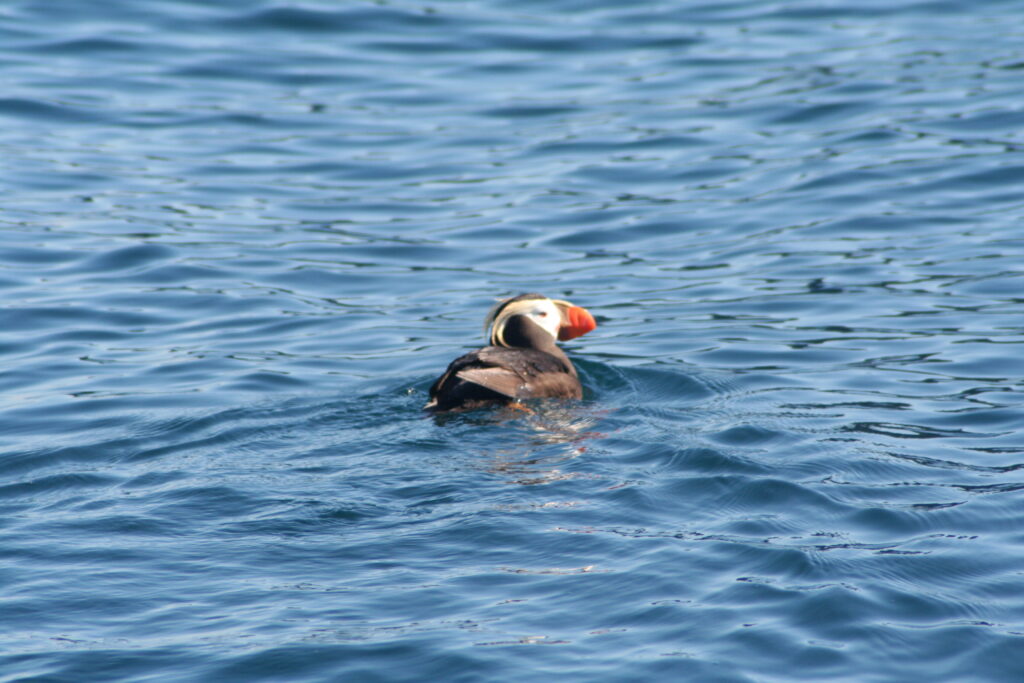
Sea Gulls
Sea gulls are a common sight in Alaska especially around fishing boats. The glaucous-winged gulls and the herring gulls look very similar, but if you can get close enough to see their eye color, you can tell the two apart. Glaucous-winged gulls have brown eyes and herring gulls have yellow eyes. They have been known to interbreed.

Whales
Several whale species feed off the coast of Alaska in the summer. Minke, sei, blue, Northern Right, fin, bowhead, sperm, and beluga whales are right at home in the waters of Alaska. There is a possibility of seeing belugas within the Turnagain Arm south of Anchorage, but it’s a slim chance. Low tide is your best bet.
Killer Whales
Orcas or killer whales are easy to spot and travel in family groups called pods. Usually there is one adult male that you can spot because of its 6-foot dorsal fin. The dorsal fins of females and juveniles are usually 3 feet or smaller. Resident killer whales that live closer to shore tend to eat mostly fish. These are the pods you will mostly likely encounter. The females stay together for life which makes it easy to observe them year after year. Wildlife tour captains will be able to tell you which resident pod they encounter by the markings on the killer whales.

Humpbacks and Gray Whales
Humpback whales migrating from Mexico and Hawaii are the easiest ones to spot because of their long pectoral fins. They’ve been observed using a technique called bubble net feeding where one whale releases bubbles underneath a ball of krill and the others swim in circles to tighten the ball. Then they lunge up swallowing over a ton of krill in one big gulp.
The other whale you might see often is the gray whale. Gray whales have a dorsal ridge instead of a dorsal fin like humpbacks and are a dark gray color with white splotches mostly on the head and tail.

Dolphins and Porpoises
You may spot Dall’s porpoises riding the bow wave of your wildlife cruise. These fast- moving mammals have the same markings as killer whales, but are much smaller. Other dolphins and porpoises you might see are white-sided dolphins, also very fast swimmers and acrobatic, and the shyer more tranquil harbor porpoises in calm waters near the coastline.

Steller Sea Lions
Steller sea lions are the Arnold Schwarzenegger of sea lions. They are massive! A typical male California sea lion weighs 800 pounds. A male Steller sea lion weighs 2500 pounds. Sea lions are easy to spot while sunning on the rocks. During our wildlife tour we watched a young sea lion playing with a whale (not an orca).


Seals
Harbor Seals and Gray Seals are the most common seals you will encounter in Alaska. Because they are both gray with spots, the way you can tell them apart is by looking at their faces. A harbor seal will have puppy eyes and a heart shaped nose. The nostrils on a gray seal are further apart and they look more like a fancy antique key handle from the first Harry Potter movie. On land, a gray seal is three times larger than a harbor seal.
In Homer, it’s common for harbor seals to hitch a ride on your kayak while you cruise around Kachemak Bay. Hopefully you have good balance because harbor seals can weigh up to 185 pounds! If that’s too close of an encounter for you, both seals can be seen sunning themselves on rocks along the coast.

Guaranteed Widlife Sightings With These Tours
and Conservation Centers
Viewing wildlife in its natural surroundings is always a thrill, but some are hard to spot even if you camped all week in the wilderness. Chance encounters of moose or Dall sheep while driving along the highway are possible, but it’s highly unlikely a pullout will be available to stop. Whether you have a day, a week or maybe a whole summer to explore Alaska, here’s a few places dedicated to the conservation of wildlife that increase your chances of seeing wildlife in Alaska.
Wildlife Cruise Tours
Most coastal towns will have boat tours to view glaciers and wildlife. Homer, Whittier, and Seward are some of the best launching points where you can see coastal wildlife like Stellar sea lions, puffins and sea otters. Stand near the bow, and you may see Dall’s porpoise riding the bow wave for fun.

Alaska Sea Life Center in Seward
The Alaska Sea Life Center is the only authorized marine life rehabilitation center in the state of Alaska. Scientists partner with the aquarium to study the cold-water environment and climate effects on the food chain spectrum from plankton to sea lion. The exhibits mimic the Alaskan coast and underwater environment with native jellyfish and other invertebrates, a puffin rookery and Stellar sea lion research just to name a few.
Please consider making a donation directly to ASLC through this link so that marine life will have an advocate for years to come.
Denali National Park and Preserve
Six million acres in Central Alaska are devoted to conservation and preservation in Denali National Park and Preserve. As extensive as this land is, it’s still one of the best opportunities to see wildlife in the wild. While every visit is different, I was lucky enough to see caribou crossing streams, bears traversing the grassland and a fox family tucked away in the hill. The animals look miniature compared to the mountainous landscape and this is where a good camera and telephoto lens will come in handy.
Read our post: Road Trip to Denali National Park and Other Alaska Adventures
Alaska Wildlife Conservation Center
The Alaska Wildlife Conservation Center is a non-profit wildlife center that is home to mostly orphaned and injured animals. The AWCC has been an important establishment to bringing wood bison back into Alaska. This is a wonderful place with large natural enclosures. You can walk, bike or drive through the park. This is the safest place to get within 20 feet of black and brown bears and see moose up close. It’s also the only place on the mainland where you can see Roosevelt elk.
Musk Ox Farm

The Musk Ox Farm started in 1954 just outside Palmer, Alaska 45 minutes north of Anchorage. This farm initiative was started in 1954 to preserve the musk ox and the native Alaskan trade. The domesticated musk oxen provide quiviut, the under-wool of a musk ox coat that keeps them warm in Alaska’s freezing winters. This hair is naturally shed from musk ox in the spring. By training the musk ox to come in for a brushing, the local people can collect the quiviut with a long-toothed hair comb to make yarn and clothing.
Quiviut is 8 times warmer than sheep’s wool and softer than cashmere. Each animal produces an average of 5 pounds of quiviut. Wild musk oxen still roam Alaska, but their herds are scattered to the far corners of northern and central Alaska with a population just of just over 2000.
You can visit the Musk Ox Farm on a road trip from Anchorage to Valdez.




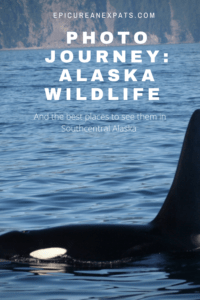




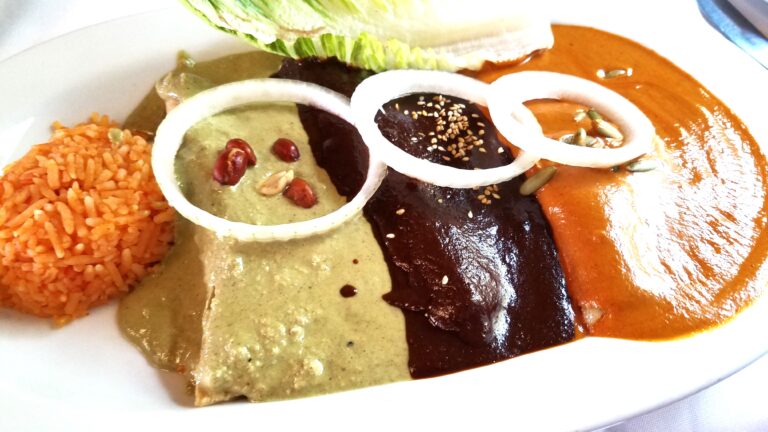

These photos are incredible! Alaska has been on my bucket list for a long time and I can’t wait to go. I had no idea you could see so many different animals there. The bears and whales particularly blew me away!